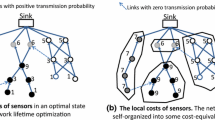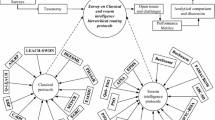Abstract
Large scale wireless sensor networks raise many challenges in the design of efficient and effective routing algorithm due to their complexity and hardware constraints. However, the scalability challenge may be mitigated from a macroscopic perspective. One example is the distributed De la Garza iteration (DDLGI) algorithm for global routing load-balancing, based on a set of partial differential equations iteratively solved by the De la Garza method. We theoretically analyze the parallelism of DDLGI and illustrate that the region of interest may impact the degree of parallelism and error. Furthermore, though DDLGI always converges, the slow convergence and long-range information exchange problems may lead to excess energy consumption in communication. Thus, we propose various enhanced De la Garza routing (E-DLGR) algorithms to alleviate the energy consumption problem by which nodes may exchange less information and only need to exchange information with closer nodes to complete each iteration. Our theoretical analysis and simulation results show that the proposed E-DLGR algorithms may have less transmission overhead, thus further reducing energy consumption, and converge faster while still maintaining adequate accuracy.














Similar content being viewed by others
Notes
More precisely, the forward sweep begins from the grid points called TL-initiators which have no up and left adjacent grid points.
Via \(\hbox {PRECISE}\) referring to Sect. 4.1.
Via \(\hbox {DONE}\) referring to Sect. 4.1.
The grid points with the same value of \({\mathcal{O}}_{L}^{\scriptscriptstyle DG}\) may update their \(\varPhi \)s simultaneously.
Since DDLGI, E-DLGR1, and E-DLGR2 maintain the lexicographical order of updating \(\varPhi \)s via (13) or equivalently (16); thus, the routing vector fields obtained from these three approaches are same.
Each ROI is divided into \(20 \times 20\) grids. Thus each ROI has \(21 \times 21\) grid points, and some grid points are not in the ROI.
References
Akyildiz, I. F., Su, W., Sankarasubramaniam, Y., & Cayirci, E. E. (2002). A survey on sensor networks. IEEE Communications Magazine, 40(8), 102–114.
Björck, Å., & Elfving, T. (1979). Accelerated projection methods for computing pseudoinverse solutions of systems of linear equations. BIT Numerical Mathematics, 19(2), 145–163.
Boyd, S., Parikh, N., Chu, E., Peleato, B., & Eckstein, J. (2011). Distributed optimization and statistical learning via the alternating direction method of multipliers. Foundation and Trends in Machine Learning, 3(1), 1–122.
Catanuto, R., Toumpis, S., & Morabito, G. (2007). Opti{c, m}al: Optical/optimal routing in Massively dense wireless networks. In Proceedings of IEEE INFOCOM (pp. 1010–1018). Alaska, USA: Anchorage.
Catanuto, R., Toumpis, S., & Morabito, G. (2009). On asymptotically optimal routing in large wireless networks and geometrical optics analogy. Computer Networks, 53(11), 1939–1955.
Chen, M., Leung, V. C., Mao, S., & Kwon, T. (2009). Receiver-oriented load-balancing and reliable routing in wireless sensor networks. Wireless Communications and Mobile Computing, 9(3), 405–416.
Chiasserini, C. F., Gaeta, R., Garetto, M., Gribaudo, M., Manini, D., & Sereno, M. (2007). Fluid models for large-scale wireless sensor networks. Performance Evaluation, 64(7–8), 715–736.
Farhat, C., Lesoinne, M., LeTallec, P., Pierson, K., & Rixen, D. (2001). FETI-DP: A dual-primal unified FETI method-part I: A faster alternative to the two-level FETI method. International Journal for Numerical Methods in Engineering, 50(7), 1523–1544.
Finn, G. G. (1987). Routing and addressing problems in large Metropolitan-scale internetworks. Research ISI/RR-87-180, Information Sciences Institute.
Golub, G. H., & Van Loan, C. F. (1996). Matrix computations (3rd ed.). Baltimore: The Johns Hopkins University Press.
Hyytiä, E., & Virtamo, J. (2007). On optimality of single-path routes in massively dense wireless multi-hop networks. In Proceedings of the 10th ACM symposium on modeling, analysis, and simulation of wireless and mobile systems (pp. 28–35). Chania, Crete Island, Greece: ACM.
Hyytiä, E., & Virtamo, J. (2009). On the optimality of field-line routing in massively dense wireless multi-hop networks. Performance Evaluation, 66(3–5), 158–172.
Jacquet, P. (2004). Geometry of information propagation in massively dense ad hoc networks. In Proceedings of the 5th ACM international symposium on mobile ad hoc networking and computing (pp. 157–162). Tokyo, Japan: Roppongi Hills.
Jung, S., Kserawi, M., Lee, D., & Rhee, J. K. K. (2009). Distributed potential field based routing and autonomous load balancing for wireless mesh networks. IEEE Communications Letters, 13(6), 429–431.
Kalantari, M., & Shayman, M. (2006). Design optimization of multi-sink sensor networks by analogy to electrostatic theory. In Proceedings of IEEE wireless communications and networking conference (pp. 431–438). NV USA: Las Vegas.
Karp, B., & Kung, H. T. (2000). GPSR: Greedy perimeter stateless routing for wireless networks. In Proceedings of the 6th annual international conference on mobile computing and networking (pp. 243–254). Boston, MA, USA: ACM.
Ko, R. S. (2011). A distributed routing algorithm for sensor networks derived from macroscopic models. Computer Networks, 55(1), 314–329.
Ko, R. S. (2011). Macroscopic analysis of wireless sensor network routing problems. Adhoc & Sensor Wireless Networks, 13(1–2), 59–85.
Liu, L., Khodaei, A., Yin, W., & Han, Z. (2013). A distribute parallel approach for big data scale optimal power flow with security constraints. In The 4th IEEE international conference on smart grid communications (pp. 774–778). Canada: Vancouver.
Marsden, J. E., & Tromba, A. J. (2003). Vector calculus (5th ed.). San Francisco: W. H. Freeman.
Toselli, A., & Widlund, O. (2005). Domain decomposition methods—algorithms and theory. Berlin: Springer.
Toumpis, S. (2008). Mother nature knows best: A survey of recent results on wireless networks based on analogies with physics. Computer Networks, 52(2), 360–383.
Toussaint, G. T. (1980). The relative neighbourhood graph of a finite planar set. Pattern Recognition, 12(4), 261–268.
Yu, Y., Govindan, R., & Estrin, D. (2001). Geographical and energy aware routing: A recursive data dissemination protocol for wireless sensor networks. Technical Report UCLA/CSD-TR-01-0023, Computer Science Department, UCLA.
Zhao, F., & Guibas, L. (2004). Wireless sensor networks: An information processing approach. San Francisco, CA, USA: Morgan Kaufmann Publishers Inc.
Zheng, J. Y., & Ko, R. S. (2013). Enhanced De La Garza routing algorithm for wireless sensor networks. In Proceedings of 2013 IEEE eighth international conference on intelligent sensors, sensor networks and information processing. Melbourne, Australia.
Acknowledgments
This work is supported by the National Science Council, Taiwan, under grant NSC 102-2221-E-194-035.
Author information
Authors and Affiliations
Corresponding author
Electronic supplementary material
Below is the link to the electronic supplementary material.
Rights and permissions
About this article
Cite this article
Zheng, JY., Ko, RS. Distributed De La Garza algorithm for load-balancing routing in wireless sensor networks. Wireless Netw 21, 297–314 (2015). https://doi.org/10.1007/s11276-014-0771-5
Published:
Issue Date:
DOI: https://doi.org/10.1007/s11276-014-0771-5




